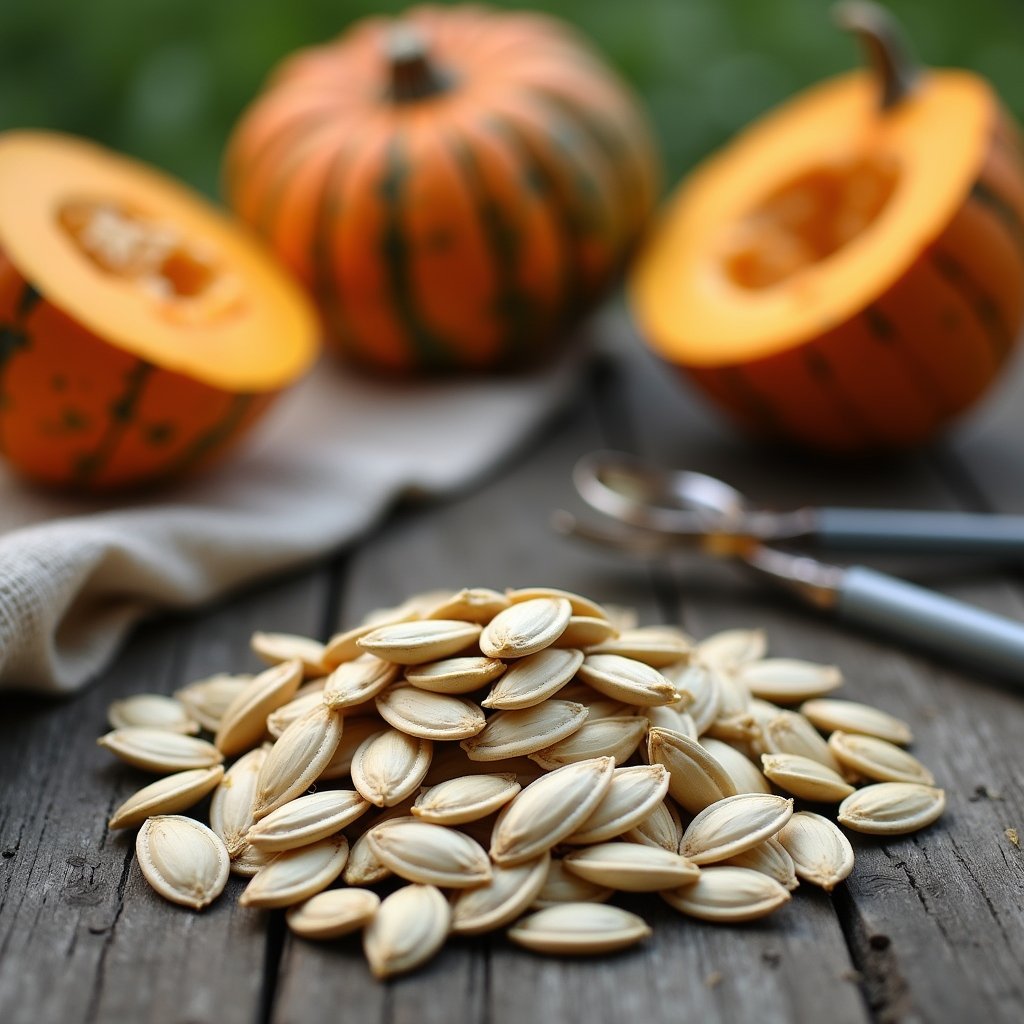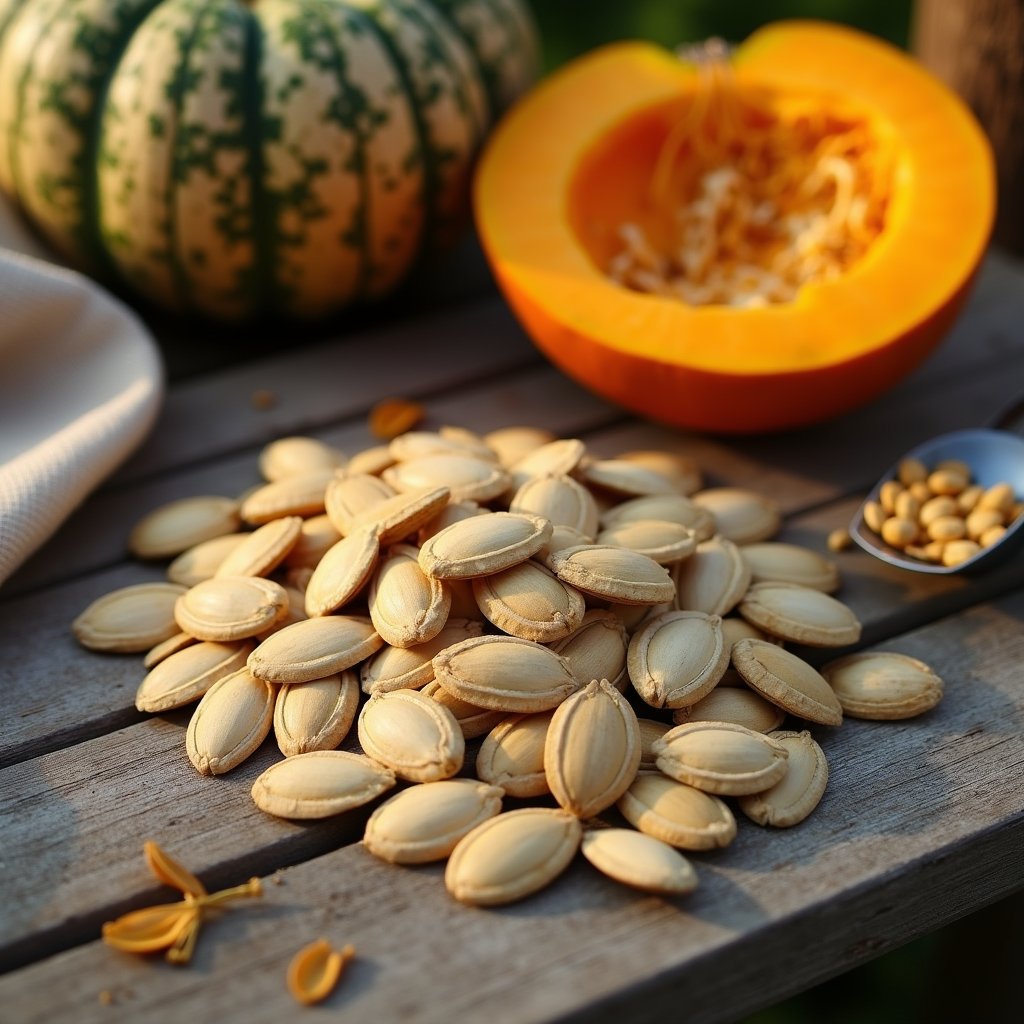You can safely eat pumpkin seed shells by properly preparing and roasting them. Start by thoroughly cleaning the seeds and soaking them in salted water for 8-24 hours to reduce phytic acid. Dry them completely, then roast at 325°F with your chosen seasonings until golden brown. Always chew thoroughly and introduce them gradually into your diet to prevent digestive discomfort. Exploring different preparation methods and seasonings can transform these fiber-rich shells into a nutritious snack.
The Nutritional Benefits of Pumpkin Seed Shells

While many people discard pumpkin seed shells, these fibrous husks contain valuable nutrients that complement the seed’s inner kernel. The shells are rich in fiber, which aids digestion and helps maintain healthy blood sugar levels. You’ll find significant amounts of lignans in the shells, compounds known for their antioxidant properties and potential cancer-fighting benefits.
The nutrient density of pumpkin seed shells includes essential minerals like zinc, magnesium, and potassium. They’re also a good source of complex carbohydrates that provide sustained energy. When you consume the shells, you’re getting supplementary protein that works alongside the protein content of the kernels. Research suggests that the shells contain unique plant compounds that may help reduce inflammation and support immune function, making them a worthwhile enhancement to your diet.
Proper Preparation Methods for Edible Shells
To safely consume pumpkin seed shells, you’ll need to thoroughly clean the seeds and soak them in salted water for 8-12 hours to soften the hulls and remove any remaining pulp. If you’re eating them raw, you can improve their palatability by adding sea salt, herbs, or spices while ensuring the shells are completely free of debris. For best texture and digestibility, roast the prepared seeds at 300°F (150°C) for 20-25 minutes, stirring occasionally until they’re crisp but not burnt.
Clean and Soak Seeds
The initial step in preparing edible pumpkin seed shells involves a thorough cleaning and soaking process to remove debris and reduce phytic acid content. You’ll want to follow specific cleaning methods and soaking durations to guarantee safe consumption.
- Rinse the seeds under cold water, removing all pulp and strings from the shells until the water runs clear
- Soak the cleaned seeds in filtered water with 1-2 tablespoons of salt for 8-24 hours to break down phytic acid
- Change the soaking water every 8 hours to prevent bacterial growth
- Pat the seeds completely dry with a clean kitchen towel before proceeding to roasting
This preparation process helps make the shells more digestible and reduces potential compounds that could interfere with mineral absorption in your body.
Seasoning Raw Shells
Once you’ve properly cleaned and dried your pumpkin seed shells, seasoning them before roasting improves both flavor and nutritional benefits. You’ll want to lightly coat the shells with olive oil to help your seasoning blends stick effectively.
| Seasoning Type | Flavor Profile | Health Benefits |
|---|---|---|
| Sea Salt & Pepper | Classic savory | Mineral-rich, digestive aid |
| Cayenne & Lime | Zesty, spicy | Metabolism increase |
| Cinnamon & Maple | Sweet, warming | Blood sugar regulation |
| Garlic & Herbs | Mediterranean | Anti-inflammatory |
For peak flavor improvement, toss your shells in your chosen seasonings while they’re still slightly damp from the oil. Don’t overseason you can always add more later. Keep in mind that different seasoning combinations can complement diverse dishes, from salads to soups, making your seasoned shells a versatile nutritious topping.
Roasting for Best Results
Proper roasting transforms pumpkin seed shells from tough and fibrous to crispy and enjoyable. The key to successful roasting techniques lies in maintaining precise temperature control and timing. You’ll need to guarantee even cooking for ideal flavor improvement and texture.
- Spread seasoned seeds in a single layer on a baking sheet and roast at 300°F (150°C) for 20-25 minutes
- Shake the pan every 10 minutes to prevent burning and promote uniform crispiness
- Watch for a golden-brown color and listen for a subtle crackling sound as indicators of readiness
- Remove from heat immediately when done to avoid bitter, overcooked shells
For best results, let the roasted seeds cool completely before eating. This cooling period allows the shells to achieve their maximum crunchiness while preserving their nutritional benefits.
Potential Risks and Safety Considerations
While pumpkin seed shells are generally safe to consume, eating large quantities can pose certain health risks. The tough, fibrous texture of shells can create choking hazards, especially for young children and elderly individuals. You’ll want to be particularly mindful of shell consumption risks like digestive discomfort or irritation of your intestinal lining.
If you have any digestive disorders or sensitivities, it’s best to remove the shells before eating the seeds. The shells’ high fiber content may cause bloating or constipation if you eat too many at once. Some shells might have sharp edges that could potentially scratch your throat or digestive tract. To minimize these risks, always chew thoroughly and start with small portions to see how your body responds.
Creative Ways to Incorporate Shell-On Seeds

Several delicious ways exist to incorporate shell-on pumpkin seeds into your daily diet. These nutrient-rich seeds can improve both taste and texture in creative recipes while providing essential fiber and minerals.
- Blend roasted shell-on seeds into smoothie bowls for added crunch and protein – they’ll create a satisfying texture while elevating nutritional content
- Mix them into homemade granola or trail mix as flavorful toppings that offer sustained energy throughout your day
- Sprinkle whole roasted seeds over salads or soups as a nutrient-dense garnish that adds both visual appeal and crunch
- Incorporate ground shell-on seeds into bread dough or homemade crackers for extra fiber and a subtle nutty flavor
Remember to thoroughly clean and dry your pumpkin seeds before using them in any recipes to promote food safety.
Roasting Techniques for Maximum Flavor
You’ll achieve best results by roasting pumpkin seeds at 300°F (150°C), which allows them to cook evenly without burning the shells. Adding your preferred seasonings before roasting helps the flavors penetrate both the shells and kernels during the heating process. Keep a close eye on your seeds as they roast, checking them every 5 minutes and removing them when they’re lightly golden brown, typically after 15-20 minutes total.
Proper Temperature Settings
To achieve perfectly roasted pumpkin seed shells, maintaining the right temperature is essential for both safety and flavor. Following proper cooking guidelines guarantees you’ll get crispy, edible shells without burning or undercooking them.
The safe temperature range for roasting pumpkin seed shells should align with these specific parameters:
- Set your oven between 300°F and 325°F for even roasting
- Maintain this temperature for 20-25 minutes, rotating the pan halfway through
- Lower the temperature to 275°F if you notice premature browning
- Avoid exceeding 350°F, as this can create harmful compounds and bitter flavors
Watch for a light golden-brown color and a crispy texture. You’ll know they’re done when the shells easily crack between your fingers without being too brittle or showing any signs of charring.
Seasoning Before Roasting
While achieving the right temperature sets the foundation for perfectly roasted pumpkin seed shells, the seasoning process beforehand determines their supreme flavor profile. You’ll want to thoroughly dry your cleaned shells before applying any seasoning blends to guarantee proper adhesion.
Toss your shells in a light coating of olive oil or avocado oil, which helps your seasonings stick while providing healthy fats. Create unique flavor profiles by combining sea salt with options like smoked paprika, cumin, or garlic powder. For a spicy kick, add cayenne or chili powder. If you prefer sweet variations, try cinnamon and a touch of coconut sugar.
Remember to distribute your seasoning blends evenly by tossing the shells in a large bowl before spreading them on your baking sheet. This guarantees consistent flavor throughout your batch.
Watch Roasting Time Carefully
Three key factors determine perfectly roasted pumpkin seed shells: time, temperature, and attention. When roasting, you’ll need to monitor these seeds closely to prevent burning, which can create harmful compounds and bitter flavors. Proper roasting techniques guarantee both safety and ideal taste.
- Set your oven between 325-350°F for even cooking
- Make timing adjustments based on seed size – larger seeds need 15-20 minutes
- Shake the pan every 5 minutes to prevent sticking and guarantee even browning
- Watch for a golden-brown color and listen for a subtle crackling sound
You’ll know your pumpkin seed shells are perfectly roasted when they’re crispy but not darkened. If you smell any burning, remove them immediately. This careful attention to roasting time creates shells that are both safe to eat and deliciously crunchy.
Storage Tips for Shell-On Pumpkin Seeds
Once you’ve prepared your shell-on pumpkin seeds, proper storage becomes essential for maintaining their freshness and nutritional value. Store them in an airtight container, and place them in a cool, dark location to enhance seed longevity. Your pantry or kitchen cabinet will work well, as long as it’s away from direct sunlight and heat sources.
Under ideal storage conditions, roasted shell-on pumpkin seeds can last up to three months at room temperature. If you want them to last longer, store them in the refrigerator, where they’ll stay fresh for up to six months. For extended preservation, you can freeze them for up to a year. Just make sure to use a freezer-safe container and remove as much air as possible to prevent freezer burn.
Digestion and Fiber Content Explained

The fiber content in pumpkin seed shells plays a major role in their digestive impact. These tough outer shells are rich in insoluble fiber, which can support your digestive health when consumed properly.
You’ll find several fiber benefits from eating shell-on pumpkin seeds:
- Promotes regular bowel movements by adding bulk to stool
- Helps maintain healthy gut bacteria and microbiome balance
- Reduces the risk of constipation when paired with adequate water intake
- Contributes to feeling fuller longer, supporting weight management goals
While the shells are generally safe to eat, you should introduce them gradually into your diet to avoid digestive discomfort. If you have sensitive digestion or inflammatory bowel conditions, it’s best to consult your healthcare provider before consuming pumpkin seed shells regularly. Remember to chew thoroughly and stay hydrated when eating fiber-rich foods.
Recipe Ideas Using Whole Pumpkin Seeds
Versatile and nutrient-rich, whole pumpkin seeds can transform everyday recipes into nutritional powerhouses. You’ll find that roasted whole pumpkin seeds work perfectly as crunchy salad toppers, yogurt mix-ins, or homemade granola enhancements.
For simple pumpkin seed snacks, toss the whole seeds with olive oil and your choice of seasonings – try sea salt and garlic powder for savory options, or cinnamon and maple syrup for sweet varieties. Shell recipes can include grinding whole seeds into a nutrient-dense flour for baking or blending them into smoothies for added protein and fiber.
You can also incorporate whole pumpkin seeds into energy bars, trail mixes, or as a crunchy coating for chicken and fish. Their sturdy shells hold up well during cooking, maintaining both texture and nutritional benefits.
Frequently Asked Questions
Can You Eat Raw Pumpkin Seed Shells Straight From the Pumpkin?
You can eat raw pumpkin seeds with their shells straight from the pumpkin, but it’s not the most pleasant or digestible option. While pumpkin shell nutrition includes beneficial fiber and minerals, raw shells are tough and fibrous, which can be hard on your digestive system. You’ll get better nutrition and enjoyment if you clean the seeds initially and either roast them or eat just the inner green seeds (pepitas).
Are Pumpkin Seed Shells From Store-Bought Pumpkins Different From Carving Pumpkins?
No, pumpkin seed shells from store-bought pumpkins aren’t different from carving pumpkins – they’re from the same species (Cucurbita pepo). However, if you’re looking for ideal culinary uses and nutritional benefits, you’ll want to choose pie pumpkins or other edible varieties. These tend to have larger, plumper seeds that are better suited for eating. All pumpkin seed shells contain fiber and minerals, regardless of their source.
Do Different Pumpkin Varieties Have Shells That Are Easier to Eat?
Did you know that there are over 45 edible varieties of pumpkin? In terms of shell thickness comparison, you’ll find that smaller pumpkin varieties like Styrian and Lady Godiva produce seeds with thinner, more tender shells that are easier to eat. These varieties also offer distinct flavor profiles Styrian seeds have a nutty, mild taste, while Lady Godiva seeds tend to be sweeter. You’ll notice that larger carving pumpkins typically have tougher, more fibrous shells.
Can Pets Safely Consume Pumpkin Seed Shells?
You shouldn’t let your pets eat pumpkin seed shells, as they pose significant pet safety risks. While pets can safely digest plain pumpkin flesh and seedless pulp, the shells are tough and fibrous, which can cause intestinal blockages or damage to their digestive tract. If you’d like to give your pet pumpkin-based treats, stick to unseasoned, cooked pumpkin flesh or shell-free seeds, which support healthy pumpkin digestion in animals.
At What Age Can Children Start Eating Pumpkin Seeds With Shells?
Like a child’s initial steps, introducing pumpkin seeds should be done with caution. You’ll want to wait until your child is at least 5 years of maturity before offering whole pumpkin seeds with shells, as they can pose a choking hazard for younger children. For safe consumption and nutritional benefits, you can start with shelled pumpkin seeds around the age of 3. Always supervise your children while they’re eating seeds and teach them to chew thoroughly.


No responses yet